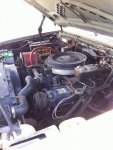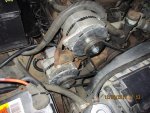How do you keep this mod from cooking a flat front battery with too many amps?
I got the answer from an engineer at a major US battery manufacturer. Here is my not-brief-enough summary, for those who might have the same question I had. For the experts out there, if I misunderstood something and there is an error in this post, please let me know and I'll fix it.
Assuming it's calibrated for charging lead/acid batteries, when a 12v alternator is running, it wants its output voltage to be around 14.5v. If the voltage is lower, the alternator pumps out as many amps as necessary to raise the voltage to 14.5v. If the load exceed's the alternator's capacity, the voltage will drop.
Battery capacity is tricky to measure. It depends on temperature and the rate at which you draw current. Cold Cranking Amps is one common measure, but there are others. Within limits, the more slowly you draw from an automotive battery, the more total amps you can extract. The warmer the battery, the more amps you can extract. C/20 is the Current, in amps, that the battery can provide continuously for 20 hours before depletion, at 77 degrees F. C/100 will be a bigger number, and C/10 will be smaller.
When you charge a depleted battery, there is a limit to the amount of current (amps) it can absorb. That limit is often about 10-20% of the battery's C/20. If the alternator exceeds the battery's max absorption rate and sends more amps than the battery can absorb, the voltage rises. Once the voltage hits 14.5v, the alternator stops trying to send more current. As the battery recharges, its absorption rate falls, and the number of amps required to hit 14.5v also falls, so the alternator puts out fewer and fewer amps as the battery charges.
If the battery is depleted and the alternator is small, the alternator may not be able to put out enough amps to raise the voltage to 14.5v. Then the alternator will crank out as many amps as it can, until the battery becomes charged enough that the voltage rises to 14.5v. At that point, the alternator will reduce the current it produces in order to maintain 14.5v.
For my M1010, soon to have the plan B mod, the new top alternator will put out up to 200 amps at 12V. When fully depleted, the new battery can absorb 30 amps. This leaves 170 amps of alternator output available for other 12V loads, like headlights etc. The alternator can't tell where its amps are going. It just puts out enough amps to maintain 14.5v.
The only time a battery gets damaged by charging is if the voltage gets too high. As long as the voltage regulator keeps the max voltage at around 14.5v, the battery will be happy. (14.5 is the magic number for lead/acid batteries. Charging voltages are different for AGM and Gel batteries.)
When the DUVAC fried front batteries, it was trying to regulate a 24v alternator to produce 14.5v, but that alternator's designed minimum output is 18v. No wonder the front batteries got fried.
So a properly adjusted high-output alternator should not damage a battery by overcharging, as long as that alternator's voltage regulator keeps the voltage below that battery's max.
With this understanding, my M1010 is getting a new Bosch 200 amp 12v alternator. This was the least expensive quality alternator readily available that would fit. It's also getting new commercial grade batteries. The DUVAC is not connected anymore.
My thanks to those who pioneered and recommended this approach. It's much more economical than a battery equalizer, and uses readily available parts that any mechanic knows well.
Correction: The readily-available Bosch alternator does not fit, in spite of all the alternator guy's assurances. So it goes back and we ordered the not-so-readily-available Neece alternator recommended by the OP.








 Like it?
Like it?